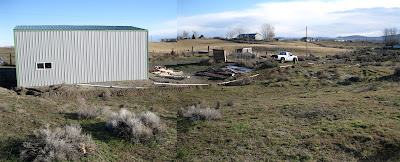We (Tres especially) have big plans for a garden next spring, but it will take some work before we get there. The number one consideration, obviously, is that we live in a desert and so will need a reasonable and efficient way to get water to our future fruits and vegetables. Up until now, our water has come from the well to the back corner of the shop. Our goal was to bring it down to the bottom of our property, where we can then attach sprinklers, drip tape, etc. to extend to the garden.
How to accomplish such a thing, you ask? Well, you're going to need a Dingo. Now, you know that I'm generally a big fan of operating heavy machinery, but this one was a bit more work for me. In order to get the Dingo to move, you squeeze and pull a horizontally-mounted bar towards you, using only your fingers. To turn and move it, you twist the bar and pull it at an angle. Sounds easy, but simultaneously squeezing and turning, with all of my weight pressing down on my hands, had my wrist feeling more than a little sore the next morning. Still, we reached our goal, a 3 foot (or so) deep ditch from our water to the bottom of the property.
I want to clear up any misapprehensions that we knew at all what we were doing when we began this undertaking. The truth is, that while I may present us as somewhat knowledgeable or competent, for the most part, we have no idea what we're doing when it comes to most of these construction/home projects. We do our best to educate ourselves by talking to the people from whom we buy our materials, looking online, and consulting more experienced family members, but the truth is that you can read and talk as much as you want, but nothing beats experience. We learn that lesson over and over, as we undertake these little projects, but it hit home especially well as we were digging the ditch yesterday. Within perhaps 10 minutes of driving, I managed to run the wheels out of their track. Lacking the proper tools and knowledge to get it back on, we called the rental company and waited while they sent someone out, who fixed it (after borrowing some tools from us - guess we had them after all!) and advised us that it happens periodically and that we should try to keep the tracks level to each other, in order to avoid it happening again.

Tres gets me back on track
With that, I was back to it and determined to make up for lost time. It turns out that I got a bit off track and we decided, so as to be thrifty with the PVC (this is all about laying pipes, don't forget) and, more importantly, to avoid the site of our future septic field, that we'd correct by digging a second trench off of the original and filling in the error. So, Tres got on the Dingo (I was not feeling confident enough in my steering), lined us up, and promptly got the tracks stuck in the trench. By the time we'd finished maneuvering a bit, the entire Dingo was on its side in the trench. Oh boy. Now, this piece of equipment weighs about 4,000 pounds. We would not be picking it up, dusting ourselves off, etc. There is no photo of these events, as we were freaking out and hardly wanted to document the moment (a bit of a regret now, as it was a sight to see). Tres came to his senses and went to the neighbors (without whom we would truly be lost, I suspect, as they have helped us out of a jam on more than one occasion) for advice and help. One kindly brought over his tractor and he and Tres easily extracted the Dingo without any damage or (additional) consternation. I continued my trenching without any further mishaps, while Tres glued the PVC together and lined it up next to the hole.

When I had finished, we set the pipe in the ground. The next day, Tres finished attaching it to the frost-free hydrant and tested it for leaks, then used the tractor to fill it in.
One step closer to the garden of our dreams!











